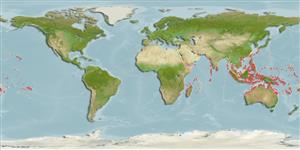Classification / Names
Common names | Synonyms | Catalog of Fishes (gen., sp.) | ITIS | CoL | WoRMS | Cloffa
Environment / Climate / Range
Ecology
Marine; freshwater; brackish; reef-associated; catadromous (Ref. 46888); depth range 0 - 5 m (Ref. 89972). Tropical, preferred ?; 32°N - 24°S, 30°E - 141°W
Indo-Pacific: Red Sea and East Africa to the Tuamoto Islands, north to southern Japan, south to southern Great Barrier Reef and New Caledonia (Ref. 9812).
Size / Weight / Age
Maturity: Lm ? range ? - ? cm
Max length : 63.0 cm TL male/unsexed; (Ref. 9710); common length : 35.0 cm TL male/unsexed; (Ref. 9812)
Dorsal
spines
(total): 4 - 5;
Dorsal
soft rays
(total): 8-9;
Anal
spines: 3;
Anal
soft rays: 7 - 9. Olive-brown dorsally, flanks silvery, abdomen white or suffused pale yellow (Ref. 9812). About 6 longitudinal stripes on flanks formed by longitudinal marks on scales; scales also with darkened margins giving slight chequered appearance to flanks (Ref. 9812). Iris with yellow patches (Ref. 9812). Margins of fins dusky, otherwise yellowish white (Ref. 9812). Caudal fin distinctly yellow (Ref. 9812). Pectoral fin completely black in small fish; lower section yellowish in adults (Ref. 9812). No axillary scale visible in the pectoral fins (Ref. 1602).
Inhabit lagoons, reef flats, estuaries, and coastal creeks, in shallow coastal areas and protected sandy shores (Ref. 40488). Usually within tidal influence, but may enter fresh water, ascending 10 km into rivers (Ref. 40488). Form large schools, frequently in mangrove areas (Ref. 2334). Juveniles may be found in rice fields and mangroves and may be used as bait fish (Ref. 9812). Oviparous, eggs are pelagic and non-adhesive (Ref. 205). Feeds on phytoplankton, small algaeand detritus organisms (Ref. 89972).
Life cycle and mating behavior
Maturity | Reproduction | Spawning | Eggs | Fecundity | Larvae
Myers, R.F., 1991. Micronesian reef fishes. Second Ed. Coral Graphics, Barrigada, Guam. 298 p. (Ref. 1602)
IUCN Red List Status (Ref. 115185)
CITES (Ref. 94142)
Not Evaluated
Threat to humans
Harmless
Human uses
Fisheries: commercial; aquaculture: commercial; aquarium: commercial; bait: occasionally
More information
Common namesSynonymsMetabolismPredatorsEcotoxicologyReproductionMaturitySpawningFecundityEggsEgg development
ReferencesAquacultureAquaculture profileStrainsGeneticsAllele frequenciesHeritabilityDiseasesProcessingMass conversion
Tools
Special reports
Download XML
Internet sources
